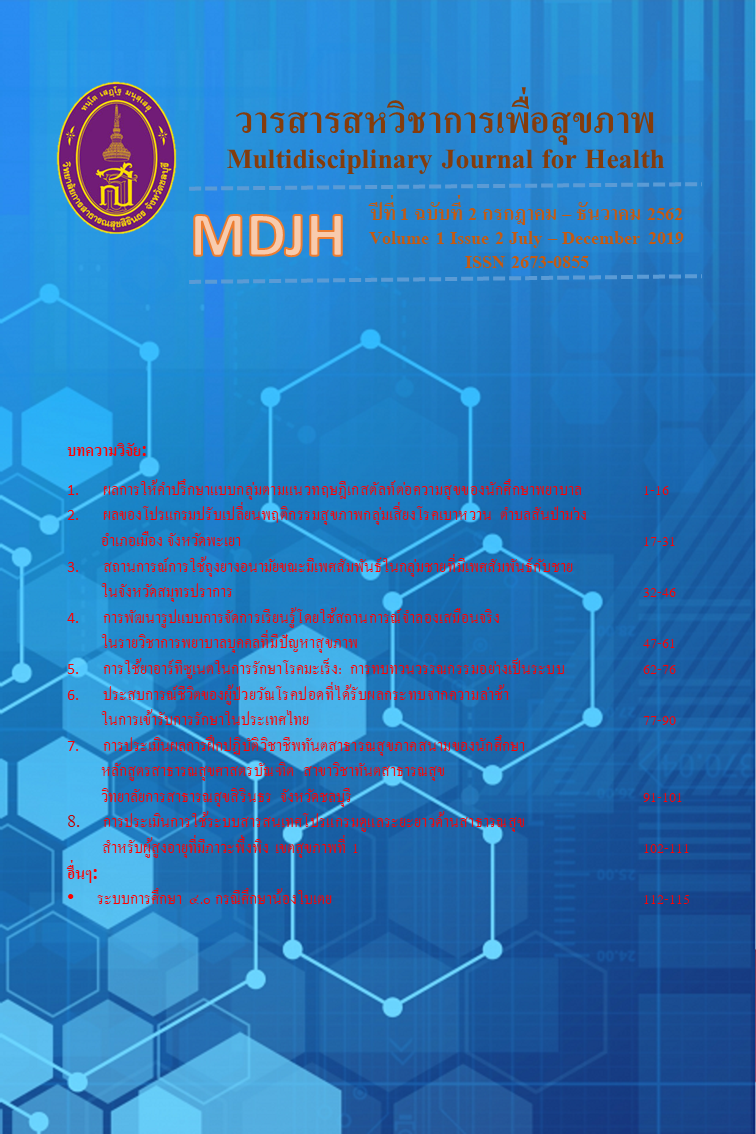การพัฒนารูปแบบการจัดการเรียนรู้โดยใช้สถานการณ์จำลองเสมือนจริงในรายวิชาการพยาบาลบุคคลที่มีปัญหาสุขภาพ
คำสำคัญ:
การพัฒนารูปแบบการจัดการเรียนรู้แบบสถานการณ์จำลองเสมือนจริง ความพึงพอใจในการเรียนรู้ ความมั่นใจในตนเอง นักศึกษาพยาบาลบทคัดย่อ
การวิจัยนี้มีวัตถุประสงค์เพื่อพัฒนารูปแบบการจัดการเรียนรู้โดยใช้สถานการณ์จำลองเสมือนจริงในรายวิชาการพยาบาลบุคคลที่มีปัญหาสุขภาพ กลุ่มตัวอย่างเป็นนักศึกษาหลักสูตรพยาบาลศาสตรบัณฑิต ชั้นปีที่ 2 จำนวน 125 ราย เลือกแบบเจาะจงตามเกณฑ์เข้ากลุ่มควบคุม จำนวน 63 ราย เรียนด้วยวิธีใช้ปัญหาเป็นฐาน และกลุ่มทดลอง จำนวน 62 ราย เครื่องมือในการเก็บรวบรวมข้อมูล ได้แก่ 1) แบบประเมินความเหมาะสมของรูปแบบการจัดการเรียนรู้โดยใช้สถานการณ์จำลองเสมือนจริง 2) แบบประเมินความเหมาะสมของคู่มือ 3) แบบทดสอบก่อนและหลังเรียน 4) แบบสอบถามความมั่นใจในการเรียนรู้ และ 5) แบบสอบถามความพึงพอใจในการเรียน ดำเนินการวิจัยระหว่างเดือนกรกฎาคา 2561 - เมษายน 2562 วิเคราะห์ข้อมูลทั่วไปด้วยสถิติบรรยาย เปรียบเทียบผลสัมฤทธิ์ทางการเรียนของนักศึกษา ความมั่นใจในการเรียนรู้ และความพึงพอใจในการเรียนโดยใช้สถิติ paired - t test และ independence - t test และวิเคราะห์ข้อมูลเชิงคุณภาพด้วยวิธีการวิเคราะห์เนื้อหา ผลการวิจัยพบว่า 1) รูปแบบการจัดการเรียนรู้โดยใช้สถานการณ์จำลองเสมือนจริงในการพยาบาลบุคคลที่มีปัญหาสุขภาพ ได้แก่ การแนะนำก่อนปฏิบัติ การปฏิบัติในสถานการณ์เสมือนจริง และการสรุปผลการปฏิบัติ 2) คะแนนสอบก่อนเรียนและหลังเรียนระหว่างกลุ่มควบคุมและกลุ่มทดลองพบว่าไม่แตกต่างกัน 3) กลุ่มทดลองมีความมั่นใจในตนเองและมีความพึงพอใจในการเรียนสูงกว่ากลุ่มควบคุมอย่างมีนัยสำคัญทางสถิติที่ระดับความเชื่อมั่นร้อยละ 95 4) การสนทนากลุ่มและการสัมภาษณ์เชิงลึกนักศึกษากล่าวคำพูดแสดงความรู้สึกกดดัน กลัว กังวล ในระระแรก และเปลี่ยนเป็นรู้สึกสนุก มีความสุขและพอใจกับการเรียนการสอนวิธีนี้ ผลการวิจัยนี้สนับสนุนให้มีการจัดการเรียนรู้โดยใช้สถานการณ์จำลองเสมือนจริง
เอกสารอ้างอิง
2. Kunaviktikul, F. Teaching and learning in the discipline of nursing in the 21st century. Nursing Journal, 2015;42(2): 52-156. (in Thai)
3. Reflection: The creative thinking process with 3 baskets. (2nd edition) Bangkok: Dennex International Corporation Limited.
4. Hovancsek M, Jeffries PR, Escudero E, Foulds BJ, Husebo SE, Iwamoto Y, et al. Creating simulation communities of practice: an international perspective. Nursing education perspectives. 2009;30(2):121-5.
5. Waxman KT. The development of evidence-based clinical simulation scenarios: guidelines for nurse educators. The Journal of nursing education. 2010;49(1):29-35.
6. Gates MG, Parr MB, Hughen JE. Enhancing nursing knowledge using high-fidelity simulation. The Journal of nursing education. 2012;51(1):9-15.
7. Liaw SY, Scherpbier A, Rethans JJ, Klainin-Yobas P. Assessment for simulation learning outcomes: a comparison of knowledge and self-reported confidence with observed clinical performance. Nurse Educ Today. 2012;32(6): e35-9.
8. Piscotty R, Grobbel C, Tzeng H-M. Integrating Quality and Safety Competencies into Undergraduate Nursing Using Student-Designed Simulation. 2011; 429-36 p.
9. Shinnick MA, Woo M, Evangelista LS. Predictors of knowledge gains using simulation in the education of prelicensure nursing students. Journal of professional nursing: official journal of the American Association of Colleges of Nursing. 2012;28(1):41-7.
10. Yuan HB, Williams BA, Fang JB, Pang D. Chinese baccalaureate nursing students' readiness for self-directed learning. Nurse Educ Today. 2012;32(4):427-31.
11. Parker RA, McNeill JA, Pelayo LW, Goei KA, Howard J, Gunter MD. Pediatric clinical simulation: a pilot project. The Journal of nursing education. 2011;50(2):105-11.
12. Shepherd C, McCunnis M, Brown L, Hair M. Investigating the use of simulation as a teaching strategy. Nurs Stand, 2010. 24(35):42-8.
13. Partin JL, Payne TA, Slemmons MF. Students' perceptions of their learning experiences using high-fidelity simulation to teach concepts relative to obstetrics. Nursing education perspectives. 2011;32(3):186-8.
14. Reese, C.E., Jeffries, P.R., & Engum, S.A. Learning together: Using simulations to develop nursing and medical student collaboration. Nursing education perspectives, 2010;31 1: 33-7.
15. Liaw SY, Scherpbier A, Rethans JJ, Klainin-Yobas P. Assessment for simulation learning outcomes: a comparison of knowledge and self-reported confidence with observed clinical performance. Nurse Educ Today. 2012;32(6): e35-9.
16. Blum, C., Borgland, S. & Parcells, D. High-fidelity nursing simulation: Impact on student self-confidence and clinical competence International Journal of Nursing Scholarship, 2010; 7 (1).
17. Kolb, D.A., Boyatizis, R.E., & Mainemelis, C. Experiential Learning Theory: Previous Research and New Directions; 1999
18. Jeffries, P. R., & Rogers, K. J. Theoretical framework for simulation design; 2012.
19. Hall, Bronwyn H. “R&D, Productivity and Market Value” Annales d’Economie et de la Statistique, forthcoming, [Internet] 2006. [cited 2019 Jan 18]; Available from: http://www.econ.berkeley.edu/ ~bhhall/bhpapers.html.
20. Cohen WM, Levin RC. Empirical studies of innovation and market structure. In: Schmalensee R, Willig R, editors. Handbook of Industrial Organization. 2: Elsevier; 1989. p. 1059-107.
21. Kolb, D.A. Experiential Learning: Experience as the Source of Learning and Development. New Jersey: Prentice-Hall, Inc. Englewood Cliffs; 1984.
22. Kolb, A. & Kolb, D. A. The Kolb Learning Style Inventory – version 3.1 2005 Technical Specifications, [Internet]. 2005[cited 2019 Jan 18]; Available from: http://www.learningfrom experience.com.
23. Sinthuchai, S. & Ubolwan, K. Fidelity Simulation-Based Learning: Implementation to Learning and Teaching Management, Journal of The Royal Thai Army Nurses, 2017, 18(1). (in Thai)
24. Jutharasaka, M. & Jutharasaka, A. 2016. Reflection: The creative thinking process with 3 baskets. (2nd ed.) Bangkok: Dennex International Corporation Limited. (in Thai)



